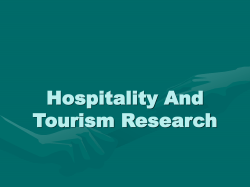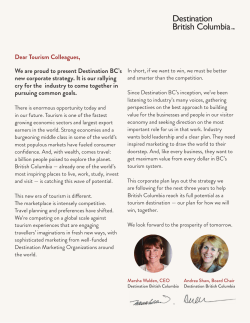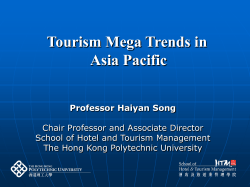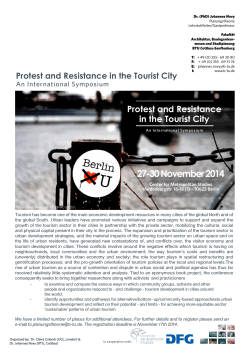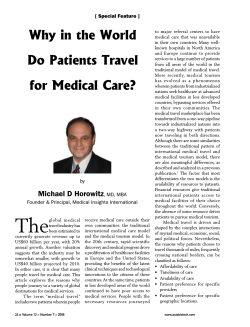
A Look at How Medical Outsourcing Can Reshape Health Care
10 BENNIE Pub Proof (Do Not Delete) 30/06/201412:06 PM Medical Tourism: A Look at How Medical Outsourcing Can Reshape Health Care REBECCA BENNIE SUMMARY INTRODUCTION ............................................................................................................... 583 I. AN OVERVIEW OF MEDICAL TOURISM ............................................................ 584 II. THE BENEFITS OF MEDICAL TOURISM ............................................................. 587 III. THE RISKS OF MEDICAL TOURISM.................................................................... 591 IV. THE UNKNOWN FUTURE OF MEDICAL TOURISM ........................................... 594 V. AUTHOR’S RECOMMENDATIONS ...................................................................... 597 A. Recommendations for the U.S. Federal and State Governments............. 597 B. Recommendations for Employers and Insurance Providers ................... 598 C. Recommendations for Patients................................................................... 598 D. Recommendations for Destination Countries ........................................... 599 CONCLUSION ................................................................................................................... 600 INTRODUCTION In a world where millions of people face healthcare costs beyond their means or years-long waits for medical procedures, an increasing number of patients are traveling internationally to receive treatment. This phenomenon has been coined J.D., The University of Texas School of Law, 2014. B.S., Law, Justice & Society, Lipscomb University, 2011. Many thanks to Jeffrey Bennie, M.D., and Jane Bennie, R.N., for the inspiration for this Note and for their invaluable support throughout the writing process. I would also like to express my sincerest gratitude to the entire Bennie and Hinson families for their love and encouragement 583 10 BENNIE Pub Proof (Do Not Delete) 584 30/06/201412:06 PM TEXAS INTERNATIONAL LAW JOURNAL [VOL. 49:583 “medical tourism.”1 Medical tourism offers many benefits to the internationally traveling patient, but the inherent risks may not be fully realized. This Note will give an overview of medical tourism then enumerate its benefits and risks. Next, the Note will discuss some factors that may shape the future of medical tourism. Finally, the author will recommend actions to be taken by both home and destination countries to regulate medical tourism and to capitalize on the opportunities it presents. I. AN OVERVIEW OF MEDICAL TOURISM Traveling abroad to receive medical care is a concept that has been around since the Roman Empire.2 In recent years, however, the demographics of medical tourism have been changing. Until recently, medical tourists were mostly residents of developed countries traveling to receive inexpensive cosmetic surgery.3 As the cost of healthcare began to rise in industrialized countries, particularly in the United States, the face of medical tourism began to change to include individuals seeking affordable and timely alternatives to surgery or treatment in their home countries.4 Today, medical tourism is estimated to be a USD 100 billion industry, and hundreds of thousands of patients are traveling abroad for medical treatment as the globalization of healthcare continues.5 Howard Bye lists six reasons people seek medical care abroad: (1) to receive specific medical treatments not found in their own countries; (2) to obtain more immediate surgery or other medical care; (3) to receive lower-cost dental and medical services; (4) to get treatment not covered by their health insurance; (5) to purchase cheaper prescription drugs; and (6) to shop for medical procedures not approved by regulatory bodies in their home countries, such as the Food and Drug Administration.6 Medical tourists commonly seek nonemergency surgical care,7 elective cosmetic surgeries,8 fertility treatments,9 and alternative, or holistic, medicine.10 While the motivations of medical tourists are varied, most tourists today fall within one of a few general categories. Some are from countries that ration healthcare, such as Canada and the United Kingdom, and are looking to avoid long 1. Angeleque Parsiyar, Comment, Medical Tourism: The Commodification of Health Care in Latin America, 15 L. & BUS. REV. AM. 379, 379 (2009). 2. Kerrie S. Howze, Note, Medical Tourism: Symptom or Cure?, 41 GA. L. REV. 1013, 1015 (2007). 3. Howard D. Bye, Shopping Abroad for Medical Care: The Next Step in Controlling the Escalating Health Care Costs of American Group Health Plans?, 19 HEALTH LAW., Apr. 2007, at 30, 30. 4. Levi Burkett, Commentary, Medical Tourism: Concerns, Benefits, and the American Legal Perspective, 28 J. LEGAL MED. 223, 224 (2007). 5. Thomas Johnsrud, Medical Travel Can Save Money During Bad Economy, but at What Cost?, J. OF COMPENSATION & BENEFITS, Mar.-Apr. 2009. 6. Bye, supra note 3, at 30. 7. Id. 8. Id. 9. Kristen Boyle, Note, A Permanent Vacation: Evaluating Medical Tourism’s Place in the United States Healthcare System, 20 HEALTH LAW., June 2008, at 42, 42. 10. See Elizabeth Gluck, Comment, “Incredible [Accreditable] India”: Trends in Hospital Accreditation Coexistent with the Growth of Medical Tourism in India, 1 ST. LOUIS U. J. HEALTH L. & POL’Y 459, 470–72 (2008) (noting that southern India is a popular destination for holistic healing approaches). 10 BENNIE Pub Proof (Do Not Delete) 2014] 30/06/201412:06 PM MEDICAL TOURISM 585 waiting lists for treatment in their home countries.11 Others are uninsured or underinsured Americans, including U.S. retirees who do not yet qualify for Medicare.12 A third group is composed of middle-class Americans seeking cosmetic surgery that is not covered by their insurance or that is cheaper than their insurance deductibles.13 The final group is the affluent upper-class of developing countries, which seeks medical care in the United States or other developed countries in order to receive a higher quality of care than the patient-tourist would receive at home.14 Other ways of categorizing medical tourists include differentiating them based on how they pay for their medical care abroad and based on destination. Tourists pay one of three ways: (1) out of pocket, (2) through private insurance that has innetwork foreign providers, and (3) through government insurance that has partnered with foreign providers.15 Medical tourists choose their destination countries using a number of different factors, and certain destination countries are known for receiving many tourists from specific home countries.16 Factors that tourists consider include distance, cultural affinities, shared language, simulated affinities, and specialization of the destination country.17 For example, these factors often lead British patients to travel to India because of the remaining English culture and widespread English-language fluency.18 An illustrative instance of simulated affinities is the Bumrungrad International Hospital in Bangkok, which has a special wing for Middle Eastern patients and boasts Arabic interpreters, halal kitchens, and Muslim prayer rugs.19 Often, simulated affinities and specializations arise as part of targeted campaigns to attract tourists from certain home countries.20 These campaigns utilize advertising through the internet, informational offices in home countries, medical-tourism seminars and exhibitions, and travel brokers.21 Some destination countries have been very intentional about creating a healthtourism industry. For example, in 2003 India’s finance minister, Jaswant Singh, called for his country to become a “global health destination.”22 Similarly, the South Korean government aggressively promoted cosmetic-surgery services in hopes of becoming “a center of excellence in that field,” thereby attracting medical tourists.23 11. Boyle, supra note 9, at 42. 12. Id. 13. Id. 14. See Alex Hunt, Comment, Inbound Medical Tourism and Visa Reform: How Increasing Accessibility for Foreign Patients Can Decrease American Healthcare Costs, 35 HOUS. J. INT’L L. 103, 109 (2013) (noting how the United States is an attractive medical-tourism destination because U.S. hospitals “offer the most advanced technologies and treatments”). 15. I. Glenn Cohen, Medical Tourism, Access to Health Care, and Global Justice, 52 VA. J. INT’L L. 1, 8 (2011) [hereinafter Cohen, Access to Health Care]. 16. I. Glenn Cohen, Protecting Patients with Passports: Medical Tourism and the Patient-Protective Argument, 95 IOWA L. REV. 1467, 1482–84 (2010) [hereinafter Cohen, Protecting Patients]. 17. Id. at 1482–83. 18. Id. at 1482. 19. Id. 20. Id. at 1482–83. 21. Id. at 1483. 22. Usha Rengachary Smerdon, Crossing Bodies, Crossing Borders: International Surrogacy Between the United States and India, 39 CUMB. L. REV. 15, 23 (2009). 23. Frank Pasquale, Access to Medicine in an Era of Fractal Inequality, 19 ANNALS HEALTH L. 269, 10 BENNIE Pub Proof (Do Not Delete) 586 TEXAS INTERNATIONAL LAW JOURNAL 30/06/201412:06 PM [VOL. 49:583 Other countries with burgeoning health-tourism industries include Mexico, Brazil, Argentina, Costa Rica, Dominican Republic, Cuba, Peru, Singapore, Hungary, Israel, Jordan, Lithuania, Malaysia, South Africa, Thailand, and the Philippines.24 Their efforts are paying off. India alone was projected to gross USD 2 billion from its health-tourism industry for 2012.25 In the United States, insurance companies and government-sponsored healthcare providers are taking tentative steps toward embracing medical tourism as a way to cut expenses in the wake of rising healthcare costs.26 The most wellpublicized case of an employer implementing medical tourism into its health plan is Blue Ridge Paper Products Inc. in Canton, North Carolina. Its Benefits Director testified at the 2006 U.S. Senate Hearing before the Special Committee on Aging entitled “The Globalization of Health Care: Can Medical Tourism Reduce Health Care Costs?”.27 In response to a projected increase in healthcare claims from USD 13 million to USD 36 million over a six-year period, Blue Ridge Paper Products began offering the option for its employees to elect to undergo surgery in India.28 To incentivize employees, the company would reimburse the employee one hundred percent and would give an additional cash incentive to cover the cost of an accompanying companion.29 The company was forced to withdraw eligibility from union employees when the United Steelworkers Union threatened an injunction, claiming the company was allowing employees to receive substandard care in a “shocking new approach” to cut costs.30 In 2006, the West Virginia State Legislature pursued the first large-scale attempt to implement medical tourism into an insurance plan.31 The proposed bill, H.B. 2841, included terms to incentivize public employees to seek medical treatment abroad.32 The bill failed due to political resistance to the idea of “outsourcing” medical care.33 While these programs met with, at best, limited success, they represent a shift that is underway in the United States toward widespread acceptance of medical tourism as a tool to combat the high costs of healthcare.34 295 (2010) (citation omitted). 24. Marcia S. Wagner, Medical Tourism and Group Health Plans, J. OF COMPENSATION & BENEFITS, Sept.-Oct. 2006. 25. Boyle, supra note 9, at 43. 26. See DELOITTE CTR. FOR HEALTH SOLUTIONS, MEDICAL TOURISM: UPDATE AND IMPLICATIONS 5–6 (2009), available at http://www.deloitte.com/assets/Dcom-UnitedStates/Local%20Assets/Documents/ us_chs_MedicalTourism_102609.pdf (summarizing pilot programs by U.S. insurance providers and legislation proposed by state legislatures that demonstrate growing attention to medical tourism). 27. The Globalization of Health Care: Can Medical Tourism Reduce Health Care Costs?: Hearing Before the Spec. Comm. on Aging, 109th Cong. 26–28 (2006) [hereinafter Medical Tourism Senate Hearing] (statement of Bonnie Blackley, Corporate Benefits Director, Blue Ridge Paper Products). 28. Id. 29. Id. at 28. 30. Christopher J. Brady, Note, Offshore Gambling: Medical Outsourcing Versus ERISA’s Fiduciary Duty Requirement, 64 WASH. & LEE L. REV. 1073, 1103–04 (2007); Saritha Rai, Union Disrupts Plan to Send Ailing Workers to India for Cheaper Medical Care, N.Y. TIMES (Oct. 11, 2006), http://www. nytimes.com/2006/10/11/business/worldbusiness/11health.html?pagewanted=all&_r=0. 31. DELOITTE CTR. FOR HEALTH SOLUTIONS, supra note 26, at 6. 32. Id. 33. Heather T. Williams, Comment, Fighting Fire with Fire: Reforming the Health Care System Through a Market-Based Approach to Medical Tourism, 89 N.C. L. REV. 607, 656 (2011). 34. Elyce Kirchner et al., US Insurance Companies Expanding Medical Tourism Coverage, NBC BAY AREA (Dec. 4, 2013), http://www.nbcbayarea.com/news/local/Medical-Tourism-The-Future-of-Healthcare- 10 BENNIE Pub Proof (Do Not Delete) 2014] 30/06/201412:06 PM MEDICAL TOURISM II. 587 THE BENEFITS OF MEDICAL TOURISM Medical tourism offers many benefits to the patient bold enough to travel to receive medical care. The most discussed benefit today is the substantial cost savings available, both to patients and insurers.35 Other positive aspects of medical tourism include state-of-the-art facilities, medical staff trained in the United States or United Kingdom, a dependable accreditation system, travel brokers who coordinate all aspects of the trip, ease of travel, travel packages and sightseeing opportunities, a spa- or resort-like atmosphere, and the wide array of treatment possibilities.36 The allure of low-cost medical care to a potential medical tourist is undeniable, especially to the uninsured and underinsured. Even under the Affordable Care Act, 23 million people are projected to remain uninsured (although this figure is down from 54 million uninsured before the Act).37 In 2006, for the first time, “the average health[]care expenditures for a family of four exceeded the entire annual earnings of a minimum-wage employee.”38 In the face of prohibitively high healthcare costs, Americans are traveling abroad for medical care by the hundreds of thousands, with a 2010 report projecting nearly 1.6 million people choosing medical tourism in 2012.39 Often, Americans, particularly the uninsured and underinsured, receive basic medical services in the United States but will travel abroad for “specialists, inpatient care, high-tech procedures, or a regimen of prescription drugs.”40 How great is the savings potential that so many people would choose to seek medical treatment in other countries? The numbers vary by destination country, but physician and facility charges are on average sixty to eight-five percent lower than negotiated charges in U.S. hospitals.41 The vast difference in charges can be found by comparing surgical and nonsurgical treatments.42 For example, a Magnetic Resonance Imaging (MRI) test costs over USD 1,000 in the United States but only USD 200 to USD 300 in Brazil, Costa Rica, India, Mexico, Singapore, or Thailand.43 Likewise, a comprehensive fitness exam in the United States costs upwards of USD 4,000 but only USD 125 in India.44 At the Senate hearing on medical tourism, 233414371.html. 35. See, e.g., Tom Murphy, Insurers Aim to Save from Overseas Medical Tourism, USA TODAY (Aug. 23, 2009), http://usatoday30.usatoday.com/news/health/2009-08-22-medical-tourism_N.htm?csp=34 (illustrating examples of how insurers “can save between 50% and 90% on major medical claims” and how patients can save significantly on out-of-pocket expenses by engaging in medical tourism). 36. Bye, supra note 3, at 31. 37. Nathan Cortez, Embracing the New Geography of Health Care: A Novel Way to Cover Those Left Out of Health Reform, 84 S. CAL. L. REV. 859, 861 (2011) [hereinafter Cortez, New Geography]. 38. Brady, supra note 30, at 1094 (citation omitted). 39. Stephen Samlan, Medical Tourism: Opportunity to Control Escalating Health Care Costs in the United States?, 20 ANNALS HEALTH L. ADVANCE DIRECTIVE 136, 136–37 (2010). 40. Cortez, New Geography, supra note 37, at 882 (quoting Lawrence D. Brown, The Amazing Noncollapsing U.S. Health Care System—Is Reform Finally at Hand?, 358 NEW ENG. J. MED. 325, 326 (2008)). 41. Wagner, supra note 24. 42. See Samlan, supra note 39, at 138 (comparing the costs of surgical and nonsurgical procedures performed in the United States to those performed abroad). 43. Id. 44. Id. 10 BENNIE Pub Proof (Do Not Delete) 588 TEXAS INTERNATIONAL LAW JOURNAL 30/06/201412:06 PM [VOL. 49:583 Howard Staab’s companion testified that in 2004 Staab needed a mitral heart valve replacement surgery within the next year to avoid life threatening heart failure.45 Being uninsured, the cost of the surgery in the United States would have totaled close to USD 200,000, including the hospital bill; the cost of the valve; and the charges of the surgeon, cardiologist, anesthesiologist, radiologist, and pathologist.46 Unable to negotiate the costs with the hospital or to find insurance that would cover his surgery within the first year of the policy, Staab traveled to India for the surgery.47 He paid in total USD 6,700, which included all hospital and doctor charges, a threeweek hospital stay for him and his companion, tests, meals, lodging, and transportation.48 A number of different factors contribute to the huge cost disparity between treatment and surgery in the United States and abroad. First, labor costs are lower, including doctors’ and nurses’ salaries, which are as little as sixty percent and five percent of their U.S. counterparts, respectively.49 Also, there is less third-party payment of medical costs by entities such as insurers, employers, and governments.50 This reduces prices in two ways: (1) by decreasing administrative costs51 and (2) by making patients more price-conscious, forcing providers to keep prices low to attract customers.52 Additionally, doctors in destination countries have less malpractice liability.53 This, too, reduces prices in two ways: (1) when doctors pay less for malpractice insurance (for instance, USD 4,000 annually in India versus USD 100,000 in the United States), the savings are passed onto the patients and (2) doctors in destination countries do not drive up medical costs by ordering unnecessary tests and procedures, which, according to advocates of malpractice reform, U.S. doctors do to minimize exposure to lawsuits because malpractice liability is so expansive in the United States.54 Finally, global suppliers charge lower prices in lower-income countries for medical devices, drugs, and products.55 Many potential medical tourists from developed countries are discouraged by a belief that medical care abroad will be of a lower quality.56 Both the destination facilities and staff, however, often meet the standard of care of developed countries and occasionally exceed it.57 To draw medical tourists, many countries have invested in state-of-the-art facilities, which are as up-to-date as those in the United States and 45. Medical Tourism Senate Hearing, supra note 27, at 2 (statement of Howard Staab and Maggi Ann Grace, patient and patient advocate). 46. Id. at 3–4. 47. Id. 48. Id. 49. Samlan, supra note 39, at 139. 50. Brad Beauvais et al., Gazing Through the Looking Glass . . . Analysis of the Impact of the US Health Care Reform Bill on the International Health & Business Landscape, in PROCEEDINGS OF THE 17TH ANNUAL S.D. INT’L BUS. CONFERENCE 50, 57 (Willard Broucek et al. eds., 2010). 51. Paula Santonocito, Medical Tourism, 18 INT’L HR J., Winter 2009. 52. Beauvais et al., supra note 50, at 57. 53. Samlan, supra note 39, at 140. 54. Id. 55. Santonocito, supra note 51. 56. See id. (discussing how when one company gauged its employees’ interest in accepting medical tourism, the responses cited quality concerns as the primary potential disadvantage). 57. Boyle, supra note 9, at 44–45 (summarizing the rigorous accreditation process used by the Joint Commission International (JCI) when evaluating medical facilities outside the United States). 10 BENNIE Pub Proof (Do Not Delete) 2014] 30/06/201412:06 PM MEDICAL TOURISM 589 other developed nations, if not more so.58 Doctors have often been trained in the United States or United Kingdom.59 Additionally, they are frequently boardcertified by U.S. medical specialty groups.60 Such is the case at Bumrungrad International Hospital in Bangkok, which has over 200 U.S. board-certified physicians.61 Medical tourists are commonly stunned by the personal attention they receive.62 When asked by the chairman of the aforementioned Senate hearing about the quality difference between hospital stays in the United States and those in India, Mr. Staab and his companion remarked that there was indeed a difference in quality: their stay in India was superior to prior hospital stays in the United States.63 They described the Indian facility as “impeccable” and the patient care as “quick” and “extraordinary.”64 While empirical work on quality-of-care disparities is lacking, some scholars argue that certain international hospitals have mortality rates of less than one percent for common, complex operations, making it virtually impossible for U.S. hospitals to claim superior quality of care in that regard.65 Despite the often high quality of medical care available abroad, in some instances lower cost does mean lower quality.66 Patients may avoid low-quality facilities by going only to accredited hospitals. In fact, accreditation has become “a de facto prerequisite for hospitals that attract foreign clientele.”67 The most wellknown international hospital accreditation organization is the Joint Commission International (JCI).68 More than 275 hospitals and other healthcare facilities have been accredited by the JCI, the global counterpart to the Joint Commission on the Accreditation of Healthcare Organizations, which accredits U.S. hospitals.69 To earn JCI accreditation, the facility must meet six overarching International Patient Safety Goals, which include over 100 standards.70 JCI president Karen Timmons described going to a JCI-accredited hospital as “essentially a risk-reduction activity.”71 “Other foreign hospitals follow the healthcare standards set by the British Standards 58. Id. at 44. 59. Id. “Ironically, there is no guarantee in the United States a patient will receive care from an American-trained doctor, nurse, or other medical professional, as many medical professionals practicing in America actually receive foreign training.” Id. 60. Id. 61. FAQs, BUMRUNGRAD INT’L HOSP., http://www.bumrungrad.com/en/hospital-faq (last visited Apr. 13, 2014) (expand the answer to Q1, which will indicate that the hospital employees over 200 U.S. board-certified doctors). 62. Boyle, supra note 9, at 44. 63. Medical Tourism Senate Hearing, supra note 27, at 5‒6 (statement of Howard Staab and Maggi Ann Grace, patient and patient advocate). 64. Id. 65. Cohen, Protecting Patients, supra note 16, at 1492. 66. See Boyle, supra note 9, at 45–46 (discussing the risks of receiving medical treatment abroad and, specifically, cases resulting in disfigurement, complications, and death for medical tourists). 67. Cortez, New Geography, supra note 37, at 907. 68. Id. at 908. 69. Id. 70. Id. 71. Adrienne Sevilla, Medical Tourism: An Informed Choice May Present a Safe and Realistic Alternative to Expensive Treatment at Home, 18 ANNALS HEALTH L. ADVANCE DIRECTIVE 103, 109 (2009) (footnote omitted). 10 BENNIE Pub Proof (Do Not Delete) 590 TEXAS INTERNATIONAL LAW JOURNAL 30/06/201412:06 PM [VOL. 49:583 Institute, the national standards organization for the United Kingdom.”72 Still other facilities seek accreditation based on Australian standards or international qualitymanagement standards.73 Patients also choose medical tourism because both increasing ease and affordability of travel over the years have made patients more willing to travel abroad,74 and entrepreneurs have capitalized on this willingness by creating medicaltourism service agencies.75 These agencies serve as intermediaries between foreign hospitals and patients, guiding the patients through the otherwise daunting task of setting up international travel and surgery.76 These companies provide a global healthcare service by partnering with foreign hospitals, offering personalized case management, coordinating pre- and post-operative needs of the patient, handling medical records, and making travel arrangements.77 Agencies, such as IndUSHealth, aim to create an experience that makes the patient feel like he or she has concierge service to compensate for the lack of a support system usually provided by the presence of family and friends.78 Hospitals in destination countries draw patients by offering accommodations and amenities that more closely resemble a spa, resort, or five-star hotel than a U.S. hospital.79 Examples include concierge service, use of cell phones, private rooms, and twenty-four-hour private nursing care.80 The Apollo Hospital Group in India offers “virtual patient visits” where patients can connect with family and friends at home.81 Medical-tourism service agencies will often set up sightseeing opportunities for their clients while they recuperate.82 Anecdotal evidence tells of some patients taking sightseeing to the extreme by going on “surgery safaris” for facelifts—after the procedure, the patient goes on a safari with medical staff in tow until bandaging is no longer necessary.83 Finally, patients turn to medical tourism because surgeries and other treatments can be available abroad before they are approved by regulators in their home 72. Bye, supra note 3, at 31. 73. Cortez, New Geography, supra note 37, at 907. 74. Boyle, supra note 9, at 43. 75. See Leigh G. Turner, Quality in Health Care and Globalization of Health Services: Accreditation and Regulatory Oversight of Medical Tourism Companies, 23 INT’L J. FOR QUALITY IN HEALTH CARE 1, 2 (2011) (discussing how medical-tourism agencies in Australia, Canada, the United Kingdom, and the United States have proliferated in the past decade alongside people’s increased interest in obtaining medical services abroad). 76. See, e.g., Medical Tourism Senate Hearing, supra note 27, at 35–36 (statement of Rajesh Rao, CEO, IndUSHealth, Inc.) (illustrating the role that a particular agency, IndUSHealth, Inc., plays in arranging plans for medical tourists). 77. Id. at 34–35. 78. See id. (“[Patients] . . . provide glowing testimonials of the level of care and attention that they receive all through the process. Their collective experiences have proven that it is indeed possible to overcome the perceived difficulties and emotional barriers that many Americans face when exposed to this new concept.”). 79. Bye, supra note 3, at 31. 80. Boyle, supra note 9, at 44. 81. Bye, supra note 3, at 31. 82. Puteri Nemie J. Kassim, Medicine Beyond Borders: The Legal and Ethical Challenges, 28 MED. & L. 439, 441 (2009). 83. Cohen, Protecting Patients, supra note 16, at 1482. 10 BENNIE Pub Proof (Do Not Delete) 2014] 30/06/201412:06 PM MEDICAL TOURISM 591 countries.84 This was the case with hip resurfacing for U.S. patients.85 This cuttingedge technology was available in India, Europe, and Asia years before the Food and Drug Administration (FDA) approved its use in the United States.86 As Nathan Cortez writes, patients are “keenly aware” that foreign regulators have approved certain procedures that the FDA has not.87 Similarly, when a procedure is still in the clinical-trial phase domestically, patients will go abroad rather than wait.88 III. THE RISKS OF MEDICAL TOURISM No matter how much research, planning, and precaution goes into a well-crafted medical-tourism trip, certain risks remain. Some of these risks are self-explanatory: travel may exacerbate a patient’s health or worsen a medical condition;89 complications in surgery or a procedure may cause a patient to stay much longer than anticipated, and when combined with time away from work, may offset financial savings;90 language or cross-cultural barriers may lead to miscommunications;91 “increased personal interconnectedness of people increases the global impact of public health threats, for example the SARS epidemic in 2003 or bioterrorism;”92 and a patient may be exposed to bacteria or diseases to which she is not immune at a time when the patient particularly susceptible.93 Other risks are no more than unsubstantiated fears, such as receiving inferior care (which is largely avoidable, as explained above) or an inability to find a domestic doctor who will consent to meet a patient’s post-treatment needs if the patient elected to travel abroad for medical care.94 However, some inherent risks are complex and carry serious consequences. These risks are a lack of remedy for medical malpractice, a possible Employee Retirement Income Security Act (ERISA) violation, a potential contribution to the corrosion of a patient’s home country’s national identity, and the possibility of a patient falling victim to misleading advertising.95 84. Nathan Cortez, Patients Without Borders: The Emerging Global Market for Patients and the Evolution of Modern Health Care, 83 IND. L.J. 71, 77 (2008) [hereinafter Cortez, Patients Without Borders]. 85. Id. at 78. 86. Id. 87. Id. 88. Brady, supra note 30, at 1099. 89. Bye, supra note 3, at 31. 90. Id. 91. Santonocito, supra note 51. 92. Nicolas P. Terry, Under-Regulated Health Care Phenomena in a Flat World: Medical Tourism and Outsourcing, 29 W. NEW ENG. L. REV. 421, 467 (2007). 93. Boyle, supra note 9, at 46. 94. Bye, supra note 3, at 31. The author has been unable to find any documented incidents of patients unable to find post-treatment care in their home countries after receiving treatment abroad. This fear appears to be probably no more than perpetuated scholarly conjecture. On the contrary, medical tourists often consult with their doctors before leaving and often go abroad with their doctors’ blessings. See, e.g., Medical Tourism Senate Hearing, supra note 27, at 4 (statement of Howard Staab and Maggi Ann Grace, patient and patient advocate) (recording testimony that a medical tourist “asked [the patient’s] cardiologist for her blessing” before traveling to India for heart surgery). 95. See Santonocito, supra note 51 (suggesting that employers ensure that they minimize their risk of ERISA violations when encouraging medical tourism); Kassim, supra note 82, at 441 (“Medical tourism is 10 BENNIE Pub Proof (Do Not Delete) 592 TEXAS INTERNATIONAL LAW JOURNAL 30/06/201412:06 PM [VOL. 49:583 U.S. medical tourists’ risk concerning a lack of legal remedy for malpractice is especially salient given the United States’ extensive patient-protection scheme.96 Americans cannot expect the same level of patient protection abroad as they receive in the United States. As Glenn Cohen explains: In the United States, there are several interlocking regulatory and tort mechanisms designed to protect patients in the healthcare setting. These include . . . the accreditation, certification, and professional self-regulation of physicians and other healthcare providers, the medical-malpractice system, reporting of malpractice suits in the National Malpractice Database, the licensure and accreditation of hospitals, medical staff bylaws, hospital privileges regulation, conflict of interest regulation, and anti-kickback statutes.97 The most glaring difference between U.S. and foreign patient protection is the difference in legal recourse for medical malpractice. In some jurisdictions, such as most Asian countries, patients sign an agreement waiving their right to sue their doctors for malpractice.98 In other countries, medical tourists may not be as aware of what risks they are assuming.99 For example, a medical tourist seeking treatment in India might be satisfied upon learning that malpractice relief is available. However, the patient probably does not know that around ninety-five percent of cases are dismissed, that he or she may face a lengthy delay before adjudication, and that the amount of litigation expenses may total more than the minimal amount of damages likely to be recoverable.100 Other countries offer equally large hurdles, ranging from high burdens of proof and procedural unfamiliarities to outright hostility toward tort claims.101 Finally, countries have different standards regarding patient consent and confidentiality, so what U.S. patients consider medical malpractice may be normal operations in a foreign hospital.102 U.S. patients looking to sue in U.S. courts are equally unlikely to find relief. First, courts are extremely unlikely to find that they have general or specific jurisdiction over a foreign doctor.103 Cary Steklof lists two exceptions: if the doctor also observed by some as corroding the basis of national health care systems based on solidarity and the promotion of shared ethical values.”); Boyle, supra note 9, at 45 (explaining the view by a major consulting firm that “the savings per procedure in low-cost Indian or Thai hospitals can be misleading”). 96. See Nathan Cortez, Recalibrating the Legal Risks of Cross-Border Health Care, 10 YALE J. HEALTH POL’Y L. & ETHICS 1, 3–4 [hereinafter Cortez, Recalibrating the Legal Risks] (discussing how “[p]atients may vaguely comprehend that they might not receive the same legal or regulatory protections overseas” and comparing the large recoveries for medical malpractice in the United States to the much smaller recoveries in popular medical-tourism destinations). 97. Cohen, Protecting Patients, supra note 16, at 1489. 98. Brady, supra note 30, at 1100. 99. Cortez, Recalibrating the Legal Risks, supra note 96, at 3 (“There is reason to suspect that [patients travelling abroad] do not fully digest just how few legal remedies remain or what options they have if something goes awry . . . . The patients diligent enough to investigate these legal disparities will not find much helpful information.”). 100. Cohen, Protecting Patients, supra note 16, at 1501. 101. Cortez, Recalibrating the Legal Risks, supra note 96, at 5–6. 102. See generally Santonocito, supra note 51 (presenting issues for consideration regarding medical tourism). 103. Cary D. Steklof, Medical Tourism and the Legal Impediments to Recovery in Cases of Medical Malpractice, 9 WASH. U. GLOBAL STUD. L. REV. 721, 731–32 (2010). 10 BENNIE Pub Proof (Do Not Delete) 2014] 30/06/201412:06 PM MEDICAL TOURISM 593 purposefully avails herself in the United States (1) through an interactive website or personal electronic communication or (2) by directly associating with a medical tourist service agency.104 Second, the patient will probably be unable to have a judgment recognized and enforced in the destination country.105 Many countries require a foreign nation’s judgment to meet local-law requirements in order to be enforced.106 Additionally, a defendant may raise the following issues to preclude enforcement: lack of reciprocity, lack of jurisdiction, public policy (many countries disfavor the punitive component of U.S. monetary judgments), or a lack of finality.107 Patients may have a better chance of seeking relief against U.S. facilitators, which could be a medical-tourism service agency, employer, or insurer.108 Patients could sue under three theories: corporate negligence, failure to obtain informed consent, and vicarious liability.109 Even under this route, the patient bears a strong risk of being denied relief.110 Fortunately, foreign physicians have strong motivation not to commit malpractice. Foreign providers understand that reputation travels quickly, and in the competitive medical-tourism market, providers are anxious to establish a “reliable international clientele” by delivering medical care beyond expectations.111 Another risk U.S. employers specifically bear is that by incorporating medical tourism as an option in an employee health plan, they risk the possibility of violating the fiduciary duty imposed by ERISA. ERISA aims to protect employees by setting minimum standards on employee benefit plans that ensure the plans will be fair and financially stable.112 Those with control over the plans have a fiduciary duty imposed by ERISA to act solely in the interest of the beneficiaries.113 Some argue that the administrator violates her duty to act solely in the interest of the beneficiaries when she “forces [the beneficiary] to choose between financial windfall for both the [beneficiary] and the plan, and regulated [domestic] versus unregulated [foreign] medical procedure.”114 Furthermore, the argument goes that medical tourism violates ERISA’s public-policy goals of equitable distribution and minimum standards of care because only the upper class can avoid the necessity to consider financial incentives for unregulated healthcare.115 Critics of this position provide three counterarguments to suggest that medical tourism actually furthers ERISA’s public-policy goals: (1) the perceived shortcomings of foreign healthcare are overstated; (2) the argument undervalues employees’ independence in decision-making; and (3) adding a medical- 104. Id. at 732–33. 105. Id. at 733. 106. Id. at 734. 107. Id. at 735–37. 108. Cortez, Recalibrating the Legal Risks, supra note 96, at 14–15. 109. Id. at 15. 110. Id. 111. Boyle, supra note 9, at 46. 112. Williams, supra note 33, at 650. 113. Id. 114. Brady, supra note 30, at 1110–11. 115. See id. at 1111 (finding a troubling effect on “middle class America” and an ERISA violation “[b]y forcing plan participants to choose between domestic care, which may result in financial devastation, and under-regulated care abroad, which leaves patients without legal remedy”). 10 BENNIE Pub Proof (Do Not Delete) 594 TEXAS INTERNATIONAL LAW JOURNAL 30/06/201412:06 PM [VOL. 49:583 tourism option is the only way some employers are able to cut enough costs to offer healthcare benefits at all.116 The risk of corroding a home country’s national identity is a long-term effect, but its consequences will affect everyone if enough people choose medical tourism to seek treatment that is illegal in their home country. Dr. Puteri Nemie J. Kassim argues that “[n]ational identity is often encoded in medico-legal rules” and that some critics view medical tourism as “corroding the basis of national health[]care systems based on solidarity and the promotion of shared ethical values.”117 Laws such as the Irish constitutional ban on abortion and Germany’s criminal prohibition of euthanasia, which reflect national taboos and the “shared ethical values” of those countries, are rendered obsolete by medical tourists seeking those treatments elsewhere.118 A risk with a more immediate effect is the possibility of falling victim to false or misleading advertising. For example, the following passage is from IndUSHealth’s website, “In instances where a medical mistake or malpractice is believed to have occurred, patients have the right to seek redress [in India] in accordance with the applicable legal statutes in their court system in a manner similar to the procedure followed here in the U.S.”119 As discussed above, this statement is not untrue, but it is clearly one-sided. Furthermore, the amount of savings a patient or employer can expect by choosing medical tourism may be overstated.120 By simply being shown a comparison of the price of treatments domestically and internationally, patients may not realize that travel costs, vendor fees, longer time away from work, and administrative costs must be taken into account.121 Employers’ savings are often further reduced by the need to provide financial incentives to employees in order for employees to be willing to travel abroad for medical treatment.122 IV. THE UNKNOWN FUTURE OF MEDICAL TOURISM Medical tourism affects more than just patients, medical providers, and insurance providers; it affects entire societies. This makes predicting the future of medical tourism difficult, especially when one considers factors like the effects on the destination countries’ populations and the possibility of future government regulation. Part IV will discuss two factors that could play a large role in the ultimate fate of medical tourism in the global health market: (1) medical tourism’s effect on the local populations of destination countries and (2) whether medical tourism should be seen as a net positive in the United States. Scholars are split as to whether medical tourism is enhancing the lives of destination countries’ local populations or worsening them. On one hand, a burgeoning medical-tourism industry reverses “brain drain”: the emigration of 116. Williams, supra note 33, at 651–52. 117. Kassim, supra note 82, at 441–42. 118. Id. 119. Frequently Asked Questions: What Happens If Something Goes Wrong?, INDUSHEALTH, http://www.indushealth.com/faq.aspx#q19 (last visited Apr. 15, 2014). 120. See Samlan, supra note 39, at 139 (outlining the position of critics that savings on procedures themselves may be misleading due to other costs). 121. Id. 122. Id. 10 BENNIE Pub Proof (Do Not Delete) 2014] 30/06/201412:06 PM MEDICAL TOURISM 595 physicians from their native countries to developed countries induced by the lure of larger salaries.123 “The entire country benefits from highly skilled doctors who stay in their countries to partake in the growing medical-tourism industry.”124 However, it is argued that these doctors specialize in areas that cater uniquely to the medical tourist, so the needs of locals remain unmet.125 In response to this, those that believe medical tourism enhances the lives of the local population argue that even if doctors are only serving the rich, the economic gains can be directed toward health services for the poor.126 In other words, there is a trickle-down effect.127 In reality, though, this has not happened, according to world-renowned health policy analyst Debora Lipson.128 Perhaps medical tourism has given destination countries the potential to improve the lives of its residents, but that potential seems to remain untapped. Studies show that a dual standard of care has developed in many destination countries. Medical tourists are driving up the cost of healthcare, making medical care unaffordable for many locals of destination countries as many of these countries are still considered developing countries.129 Additionally, as medical tourists make the private sector even more profitable, they draw away medical personnel from the local population.130 For example, in Malaysia, “private hospitals have about [twenty percent] of the overall bed capacity in the country but . . . hire [fifty-four percent] of the doctors.”131 Many hospitals that target medical tourists discourage locals from coming because it detracts from the tourists’ perspective that the trip is a luxurious getaway.132 Glenn Cohen identifies six triggering conditions that lead to reduced access to healthcare for local populations when combined with substantial amounts of medical tourism: (1) whether medical tourists are seeking services currently accessed by the destination country’s poor, (2) whether the introduction of a higherpaying market will likely cause physicians to shift away from treating patients in the lower-paying market, (3) whether the size of the healthcare workforce can increase to meet the demands of medical tourism, (4) whether nearby medical-tourism hubs in other countries will increase intraregional “brain drain,” (5) whether resources used to attract medical tourists have been redirected from basic healthcare services to an extent that it outweighs the positive healthcare spillovers, and (6) whether the 123. Pasquale, supra note 23, at 295–97 (citation omitted) (“[S]pending by the developed world can stimulate the growth of health infrastructure in the developing world,” and that conversely, “[w]hen Americans are not traveling abroad to demand the services of less developed countries’ doctors, they and other citizens of rich nations are often inducing those doctors to emigrate to the developed world.”). “For example, extreme wealth disparities mean that many Filipino physicians make more in the U.S. as nurses than they would in their home country working as doctors.” Id. at 295. 124. MILICA Z. BOOKMAN & KARLA R. BOOKMAN, MEDICAL TOURISM IN DEVELOPING COUNTRIES 178 (2007). 125. See Pasquale, supra note 23, at 295 (explaining that when the South Korean government promoted cosmetic surgery to draw medical tourists, doctors specializing in other specialties complained about the lack of interest in those specialties by new doctors). 126. Id. at 294 n.113. 127. Id. 128. Id. (citation omitted) (“It’s just not the case that [profits from medical tourism] are tapped and redirected to health services for the poor, it just does not happen.”). 129. Kassim, supra note 82, at 442. 130. Id. 131. Pasquale, supra note 23, at 295 (citations omitted). 132. Burkett, supra note 4, at 232. 10 BENNIE Pub Proof (Do Not Delete) 596 TEXAS INTERNATIONAL LAW JOURNAL 30/06/201412:06 PM [VOL. 49:583 government has structured profits from the medical-tourism industry in such a way as to trickledown to the poor.133 Whether this dual standard of care ultimately turns destination countries against the medical-tourism industry remains to be seen. Another important factor that could influence the fate of medical tourism is whether this “medical outsourcing” will help or harm the U.S. healthcare system in the long run. Many see medical tourism as an integral piece towards solving skyrocketing healthcare costs,134 but what will occur after the crisis is resolved? An extensive argument has been made that patients need to be protected from the risk of receiving poorer quality care and from medical malpractice without the possibility of legal recourse.135 Others believe the U.S. healthcare system is what needs protecting because “[t]he need to lower prices [to stay competitive with international healthcare providers] may persuade some [U.S.] healthcare providers to lower quality.”136 An alternative argument in favor of protection of the U.S. system focuses on U.S. insurance as a cost-spreading model; relying on medical tourism reduces the ability to spread costs, which could lead to an increase in surgical costs in the United States.137 Regardless of whether it is the patient or the system that is being protected, the most extreme solution suggested has been an outright ban of medical tourism.138 The Texas State Legislature took a step in this direction by passing an insurancecode provision stating that a “health benefit plan issuer may not issue or offer for sale in this state a health benefit plan that requires an enrollee to travel to a foreign country to receive a particular healthcare service under the health benefit plan.”139 A less stringent solution is to penalize medical tourists indirectly through forfeiture of Medicare/Medicaid coverage or by making medical-tourism care ineligible for tax benefits or deductions.140 Nevertheless, many scholars see medical tourism as a positive impact for both the short and long term.141 Patients need protection, but it should be selective and refined.142 An additional benefit is allowing “public policies that restrict access to certain medical procedures . . . to remain viable in the United 133. Cohen, Access to Health Care, supra note 15, at 9–13. 134. See Medical Tourism Senate Hearing, supra note 27, at 35–36 (statement of Rajexh Rao, CEO, IndUSHealth) (“[I am] proud to play a key role in providing access to [affordable] health care for a growing number of our citizens”); Boyle, supra note 9, at 42 (“Although medical tourism will not be the solution to healthcare access woes, it should be incorporated into the United States healthcare system as an option for receiving healthcare treatment.” (emphasis added)). 135. See, e.g., Cohen, Protecting Patients, supra note 16, at 1467–68 (outlining the main points of this Note on how to protect against the downsides of medical tourism). 136. Burkett, supra note 4, at 236. 137. Id. 138. Cohen, Protecting Patients, supra note 16, at 1511 (illustrating hypothetical schemes to implement a U.S. ban on medical tourism). 139. TEX. INS. CODE ANN. § 1216.004 (Vernon 2007). 140. Cohen, Protecting Patients, supra note 16, at 1512–15. 141. See, e.g., Michael Klaus, Outsourcing Vital Operations: What If U.S. Health Care Costs Drive Patients Overseas for Surgery?, 9 QUINNIPIAC HEALTH L.J. 219, 247 (2006) (encouraging Americans to embrace medical tourism for its “safe, low-cost surgeries” and for the pressure it will place on the domestic market to “adopt more efficient processes”); Williams, supra note 33, at 684 (“[M]edical tourism, despite its inherent flaws, represents a favorable option for patients as compared to the U.S. health care system.”). 142. Cf. Cohen, Protecting Patients, supra note 16, at 1515 (suggesting that fines, waiver of Medicare eligibility, or selective loss of tax deductions should be imposed only on medical tourists who use foreign providers that fail to meet certain standards). 10 BENNIE Pub Proof (Do Not Delete) 2014] 30/06/201412:06 PM MEDICAL TOURISM 597 States”—dominant public policy is upheld while those that want the procedures have access to them abroad, a “political ‘win-win.’”143 V. AUTHOR’S RECOMMENDATIONS This Part offers recommendations with the goal of safely and intelligently expanding medical tourism. The recommendations are based on the premises that medical tourism will continue to gain momentum and size144 and that governments and insurers should be encouraging medical tourism. Below, I offer recommendations for the U.S. government, insurance providers, individuals considering medical tourism, and the governments of destination countries. The recommendations have a two-part aim: (1) maximize the benefits of medical tourism and (2) minimize the risks. A. Recommendations for the U.S. Federal and State Governments State governments should pass legislation encouraging medical tourism. This would require Texas to repeal its earlier legislation. Nathan Cortez proposes five elements that such legislation should include: (1) “explicitly authorizing cross-border plans”;145 (2) giving flexibility to design plans, which “grant[s] insurers latitude to design low-cost plans that actually appeal to the uninsured;”146 (3) “specifying minimum coverage requirements”; (4) “identifying regulatory proxies to ensure quality care,” such as the JCI; and (5) “addressing legal recourse and other barriers.”147 States can address legal recourse by requiring insurers to consent to the state’s jurisdiction and to the application of the state’s law, by invalidating liability waivers that insurers may use, by requiring payors to purchase malpractice insurance, or by requiring plans to disclose that patients may not be able to seek legal relief in U.S. courts.148 Similarly, states can address the issue of continuity of care by requiring cross-border insurers to cover necessary follow-up care in the United States when a medical tourist returns.149 The federal government should require medical-tourism service agencies to obtain a license. This will provide a check on unscrupulous agents, allow regulators to keep better records of medical-tourism information, and make the market more transparent to patients.150 The U.S. Department of Health and Human Services “could license and monitor domestic employers, insurers, travel agents, brokers, and other intermediaries that send patients overseas,” and impose recordkeeping 143. Burkett, supra note 4, at 237. 144. “Ultimately, the rise of well-funded, technologically advanced, United States accredited private hospitals [abroad] will induce American patients [to become medical tourists].” Klaus, supra note 141, at 246–47. 145. California is the only state that has formally adopted cross-border insurance. Cortez, New Geography, supra note 37, at 891. 146. Id. at 894. 147. Id. at 891–98. 148. Id. at 898–99. 149. Id. at 899. 150. Cortez, Patients Without Borders, supra note 84, at 120. 10 BENNIE Pub Proof (Do Not Delete) 598 TEXAS INTERNATIONAL LAW JOURNAL 30/06/201412:06 PM [VOL. 49:583 requirements, thereby using the licensing scheme to monitor foreign providers through the licensees.151 The federal government should use “a selective loss of tax deductions” against patients who utilize a foreign facility that fails to meet certain criteria.152 This intervention works “both by pushing patients to approved medical tourism and by giving providers incentives to become approved.”153 While the United States cannot directly regulate operating standards of foreign healthcare providers, this mechanism imposes a huge incentive to meet whatever criteria the U.S. government chooses to create. B. Recommendations for Employers and Insurance Providers When developing a medical-tourism option, employers and insurance providers should “identify international medical facilities that best meet their needs and the needs of their employee population.”154 The following components are essential: price transparency and demonstrated savings, accreditation by the JCI or its equivalent, board-certified physicians in the relevant specialties, and an ability and willingness to collaborate with domestic physicians to coordinate before- and aftervoyage care.155 Employers and insurance providers should consider requiring patients and foreign providers to sign arbitration agreements. Arbitration offers a cheaper, faster alternative to litigation over alleged medical malpractice.156 Unlike judicial awards from foreign courts, countries are bound to recognize and enforce arbitral awards no matter where the parties have citizenship, so long as arbitration took place in a country that has signed on to the New York Convention.157 Arbitration removes many barriers from the medical tourist in her effort to seek relief for malpractice.158 A third recommendation is that employers and insurance providers include language in any contract with foreign hospitals or providers that complies with the Health Insurance Portability and Accountability Act’s (HIPAA) Privacy Rule and Security Rule.159 Health insurance plans must meet HIPAA’s standards even if the patient receives medical care outside the country.160 C. Recommendations for Patients There are several factors that patients should be aware of before engaging in medical tourism. First, the patient should determine if medical tourism is appropriate for her individual situation, taking into account the physical toll of travel 151. Id. at 124–25. 152. Cohen, Protecting Patients, supra note 16, at 1515. 153. Id. 154. Johnsrud, supra note 5. 155. Id. 156. Deth Sao et al., Healthcare Disputes Across National Boundaries: The Potential for Arbitration, 42 GEO. WASH. INT’L L. REV. 475, 507–08 (2010). 157. Steklof, supra note 103, at 740. 158. Id. at 741. 159. Wagner, supra note 24. 160. Id. 10 BENNIE Pub Proof (Do Not Delete) 2014] 30/06/201412:06 PM MEDICAL TOURISM 599 and the distance from family, friends, and other people in her support system.161 Patients should ensure that the foreign provider is accredited and that the physicians are credentialed, even if the trip is being coordinated by a medical-tourism service agency.162 Additionally, patients should be knowledgeable about the medicalmalpractice system in the destination country.163 Patients should consider either entering into a signed arbitration agreement164 or purchasing U.S. medicalmalpractice insurance for the trip.165 Before leaving, patients should find a doctor who agrees to manage post-treatment care.166 Finally, patients should be aware of what procedures qualify for exemption when filing taxes and what other related costs will qualify.167 D. Recommendations for Destination Countries Three actions can be taken by destination countries to ensure that their entire populations benefit from the profits of medical tourism. First, the governments should invest in state-of-the-art facilities and other draws for medical tourists in order to “lure[] back” physicians and reverse the potential effects of brain drain.168 Second, they should implement “[r]egulations that require providers to spend time in both [public and private healthcare].”169 This will allow locals to benefit from the advanced training of doctors who may otherwise spend all their time with medical tourists.170 The third action that should be taken is to cross-subsidize health care for the local populations in the public-health sector with revenue from foreign patients.171 Together, these actions can raise revenue and improve quality of care for local populations. 161. Santonocito, supra note 51. 162. See id. (placing “quality of care” as the top priority and recommending that employers ensure that their employees use properly accredited facilities when traveling abroad for health care). 163. Cohen, Protecting Patients, supra note 16, at 1506. This research will be significantly easier if the Department of Health and Human Services collects and publishes the records of licensed intermediaries, as recommended above. 164. See Sao et al., supra note 156, at 508–12 (explaining that “the availability of arbitration forums on a global scale and the binding nature of arbitration awards involving commercial disputes across national boundaries” provides more efficient and reliable forums to resolve cross-border medical malpractice claims than the courts of foreign jurisdictions). 165. Cortez, Recalibrating the Legal Risks, supra note 96, at 80–81. 166. See Bye, supra note 3, at 31 (noting that patients may encounter difficulties in finding a doctor for post-treatment care upon their return to their home countries). 167. Id. at 32–33 (summarizing the tax consequences of medical tourism, specifically noting that “treatments [that] are illegal in the United States but permissible abroad are not excludable from income”). 168. See Cortez, Patients Without Borders, supra note 84, at 110 (explaining the methods that some destination countries have used to reverse brain drain). 169. Cohen, Access to Health Care, supra note 15, at 10. 170. Id. 171. Cortez, Patients Without Borders, supra note 84, at 110. 10 BENNIE Pub Proof (Do Not Delete) 600 30/06/201412:06 PM TEXAS INTERNATIONAL LAW JOURNAL [VOL. 49:583 CONCLUSION Medical tourism has shown that “the demand for foreign medical services will continue to rise, if these services are provided with quality.”172 Medical tourism has often demonstrated its quality through its cutting-edge facilities, commitment to accreditation, attention to patient care, and the large number of physicians with U.S. credentialing and advanced medical training. This ever-growing industry holds the potential to help or harm, but through attentive planning, careful research, and a willingness to try the unprecedented, medical tourism can benefit people across the globe. 172. Thomas R. McLean, Telemedicine and the Commoditization of Medical Services, 10 DEPAUL J. HEALTH CARE L. 131, 165 (2007).
© Copyright 2025
